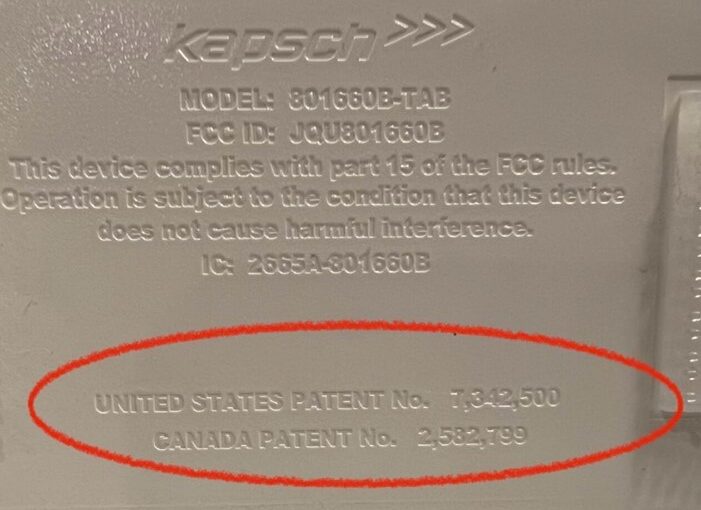
Patent Marking In the United States: Best Practices
 Patentees should clearly mark their products with the applicable patent numbers to ensure maximum infringement damages. If a patentee fails to properly mark a product, damages are statutorily limited to the date the infringer received actual notice of the infringement. In order to maximize potential damages, the patentee should develop and implement a patent marking program.
Patentees should clearly mark their products with the applicable patent numbers to ensure maximum infringement damages. If a patentee fails to properly mark a product, damages are statutorily limited to the date the infringer received actual notice of the infringement. In order to maximize potential damages, the patentee should develop and implement a patent marking program.
Is Patent Marking Required?
No. Patent marking is not required, but it is strongly recommended. A patentee that fails to mark its products cannot recover damages for infringement occurring prior to the date of actual notice of infringement.
Marking with Patent Numbers
The patent notice should be “fixed” on the actual product and should include “Patent” or “Pat.” followed by the specific patent number(s) covering that product. For example, “Patent 9,876,543” should be fixed to a product covered by that patent and sold by or under authorization of the owner of that patent.

The following image shows a patent notice fixed to a product, namely an automobile toll transponder. The patent marking is debossed on the surface and presented in a similar size and relief as other information. The marking refers to “United States Patent.” Although not required, it is helpful to include jurisdiction information to the extent the notice identifies patents from jurisdictions outside the United States, as is done here.
Where the character of the article is such that the patent number cannot be fixed thereto, the notice can be provided on a package or label for the product. For example, a price tag or product box may be appropriate alternatives to placing the notice directly on the product. Where appropriate, a sticker affixed to previously printed packaging may be the most economical way to mark the products initially.
Virtual Marking: Referencing a URL that Links to a Website with Patent Info
Notice may also be provided by marking the patented article “Patent” or “Pat.” along with the address of a website that associates the patented article with the number of a patent. Examples of acceptable markings on products or packaging include “Patent www.YourSite.com/patents” or “Pat. www.YourSite.com/patents.” This notice may also be provided on packaging or a label where the character of the article is such that the notice cannot be affixed thereto.
The website address should link to a freely accessible webpage that includes a listing or a searchable database associating patents with a particular product, sku, item number, etc. For example, the website should include: (1) a listing of product names (Branded name of the product), (2) the associated model or ID number next to each product, and (3) a list of US patents covering each product.
Maintain Records of Marking Program
The patentee should periodically review its marking program and maintain detailed records. This could include information on how each product was marked. In regard to virtual marking, it is important to document that the patent marking website is regularly accessible. It is further advisable to track visits to the patent marking website and, if possible, associate these visits with IP addresses.
The Marking Program Should Be Comprehensive
Courts have held that patent marking should be “substantially consistent and continuous.” The patentee will not forfeit pre-notice damages if it fails to mark a de minimis number of products, however the patentee should mark substantially all products.
Licensees Should Mark
Licensees under the patent are also required to mark. If a patent licensee fails to mark, the patentee’s damage recovery will be limited. Therefore, the patentee should (1) ensure there are written marking requirements in the license agreement, (2) enforce the written marking requirements against the licensee.
Patent Pending
When an application is filed it is considered pending. Until the application is abandoned or issued, an application remains pending. Products embodying the patent application should be marked as “Patent Pending.” The product can be marked with the publication number after the patent application is published.
The Patentee does Not Need to Mark If It Does Not Sell a Patented Product
If the patentee does not sell an article covered by any patent, the patentee does not need to mark.
About the Author: Walter Welsh practices patent and trademark law at his firm Welsh IP Law, an intellectual property firm based in Darien, Connecticut. Welsh IP Law works directly with engineers, scientists, and executives to develop and grow intellectual property portfolios that protect and strengthen the business position. Its clients include Fortune 500 companies, global brands, family businesses, and start-ups.

Welsh IP Law is an intellectual property law firm based in Fairfield County, Connecticut. Our passion is increasing the value of our client’s business through strategic patent and trademark protection. We work directly with engineers, scientists, and executives to develop and grow intellectual property portfolios that protect and strengthen the client’s business. Our clients include Fortune 500 companies, global brands, family businesses, and start-ups from around the world.


